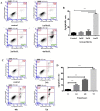Aspirin Inhibits Colorectal Cancer via the TIGIT-BCL2-BAX pathway in T Cells
- PMID: 39113892
- PMCID: PMC11302567
- DOI: 10.7150/ijms.98343
Aspirin Inhibits Colorectal Cancer via the TIGIT-BCL2-BAX pathway in T Cells
Abstract
The T cell immunoglobulin and ITAM domain (TIGIT) is a recently discovered synergistic co-suppressor molecule that plays an important role in immune response and tumor immune escape in the context of cancer. Importantly, CD155 acts as a receptor for TIGIT, and CD155 signaling to immune cells is mediated through interactions with the co-stimulatory immune receptor CD226 (DNAM-1) and the inhibitory checkpoint receptors TIGIT and CD96. Aspirin (ASA) has been shown to reduce the growth and survival of colorectal cancer (CRC) cells, but the immunological mechanisms involved have not been sufficiently elucidated. In the present study the effects of aspirin on CRC in mice and on Jurkat cells were investigated. Aspirin may suppress the expression of TIGIT on T cells and Regulatory T cells (Tregs) and inhibit T cell viability, and therefore induce tumor cell apoptosis. TIGIT is expressed at higher levels on infiltrating lymphocytes within CRC tumor tissue than adjacent. Further, aspirin could inhibit Jurkat cell proliferation and induce apoptosis via downregulation of TIGIT expression and the anti-apoptosis B cell lymphoma 2 (BCL2) protein and upregulation of BCL2-associated X protein (BAX) expression. The present study suggests that aspirin can inhibit specific aspects of T cell function by reducing interleukin-10 and transforming growth factor-β1 secretion via the TIGIT-BCL2-BAX signaling pathway, resulting in improved effector T cell function that inhibits tumor progression.
Keywords: CD155; CD226; TIGIT.; aspirin; colorectal cancer.
© The author(s).
Conflict of interest statement
Competing Interests: The authors have declared that no competing interest exists.
Figures








Similar articles
-
Use of aspirin in the prevention of colorectal cancer through TIGIT-CD155 pathway.J Cell Mol Med. 2019 Jul;23(7):4514-4522. doi: 10.1111/jcmm.14332. Epub 2019 May 14. J Cell Mol Med. 2019. PMID: 31090213 Free PMC article.
-
CD155/TIGIT signaling regulates the effector function of tumor-infiltrating CD8+ T cell by NF-κB pathway in colorectal cancer.J Gastroenterol Hepatol. 2022 Jan;37(1):154-163. doi: 10.1111/jgh.15730. Epub 2021 Nov 12. J Gastroenterol Hepatol. 2022. PMID: 34734434
-
Blockade of TIGIT/CD155 Signaling Reverses T-cell Exhaustion and Enhances Antitumor Capability in Head and Neck Squamous Cell Carcinoma.Cancer Immunol Res. 2019 Oct;7(10):1700-1713. doi: 10.1158/2326-6066.CIR-18-0725. Epub 2019 Aug 6. Cancer Immunol Res. 2019. PMID: 31387897
-
DNAM-1 versus TIGIT: competitive roles in tumor immunity and inflammatory responses.Int Immunol. 2021 Nov 25;33(12):687-692. doi: 10.1093/intimm/dxab085. Int Immunol. 2021. PMID: 34694361 Review.
-
CD155, an onco-immunologic molecule in human tumors.Cancer Sci. 2017 Oct;108(10):1934-1938. doi: 10.1111/cas.13324. Epub 2017 Aug 18. Cancer Sci. 2017. PMID: 28730595 Free PMC article. Review.
Cited by
-
Targeting DAMPs by Aspirin Inhibits Head and Neck Cancer Stem Cells and Stimulates Radio-Sensitization to Proton Therapy.Cancers (Basel). 2025 Jun 26;17(13):2157. doi: 10.3390/cancers17132157. Cancers (Basel). 2025. PMID: 40647457 Free PMC article.
-
Global research trends and hotspots in aspirin studies (2014-2024): a bibliometric perspective.Front Pharmacol. 2025 May 16;16:1513318. doi: 10.3389/fphar.2025.1513318. eCollection 2025. Front Pharmacol. 2025. PMID: 40453660 Free PMC article. Review.
-
Aspirin in Cancer Therapy: Pharmacology and Nanotechnology Advances.Int J Nanomedicine. 2025 Feb 23;20:2327-2365. doi: 10.2147/IJN.S505636. eCollection 2025. Int J Nanomedicine. 2025. PMID: 40017626 Free PMC article. Review.
References
-
- Sung H, Ferlay J, Siegel RL. et al. Global cancer statistics 2020: globocan estimates of incidence and mortality worldwide for 36 cancers in 185 countries. Ca Cancer J Clin. 2021;71:209–49. - PubMed
-
- Morgan E, Arnold M, Gini A. et al. Global burden of colorectal cancer in 2020 and 2040: incidence and mortality estimates from globocan. Gut. 2023;72:338–44. - PubMed
-
- Menter DG, Bresalier RS. An aspirin a day: new pharmacological developments and cancer chemoprevention. Annu Rev Pharmacol Toxicol. 2023;63:165–86. - PubMed
-
- Ren G, Ma Y, Wang X. et al. Aspirin blocks ampk/sirt3-mediated glycolysis to inhibit nsclc cell proliferation. Eur J Pharmacol. 2022;932:175208. - PubMed
MeSH terms
Substances
LinkOut - more resources
Full Text Sources
Medical
Research Materials

